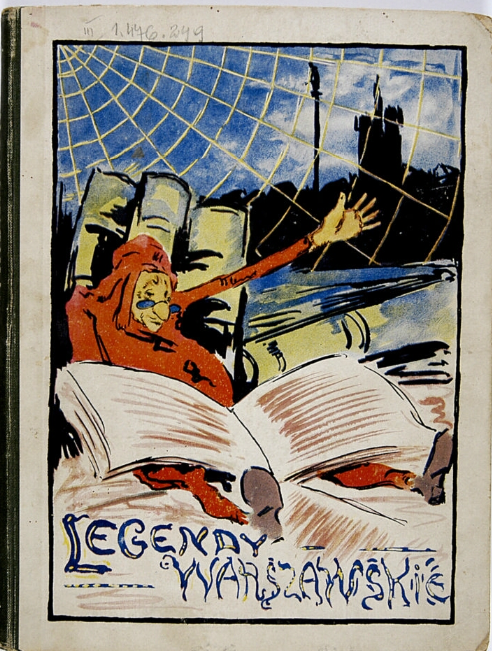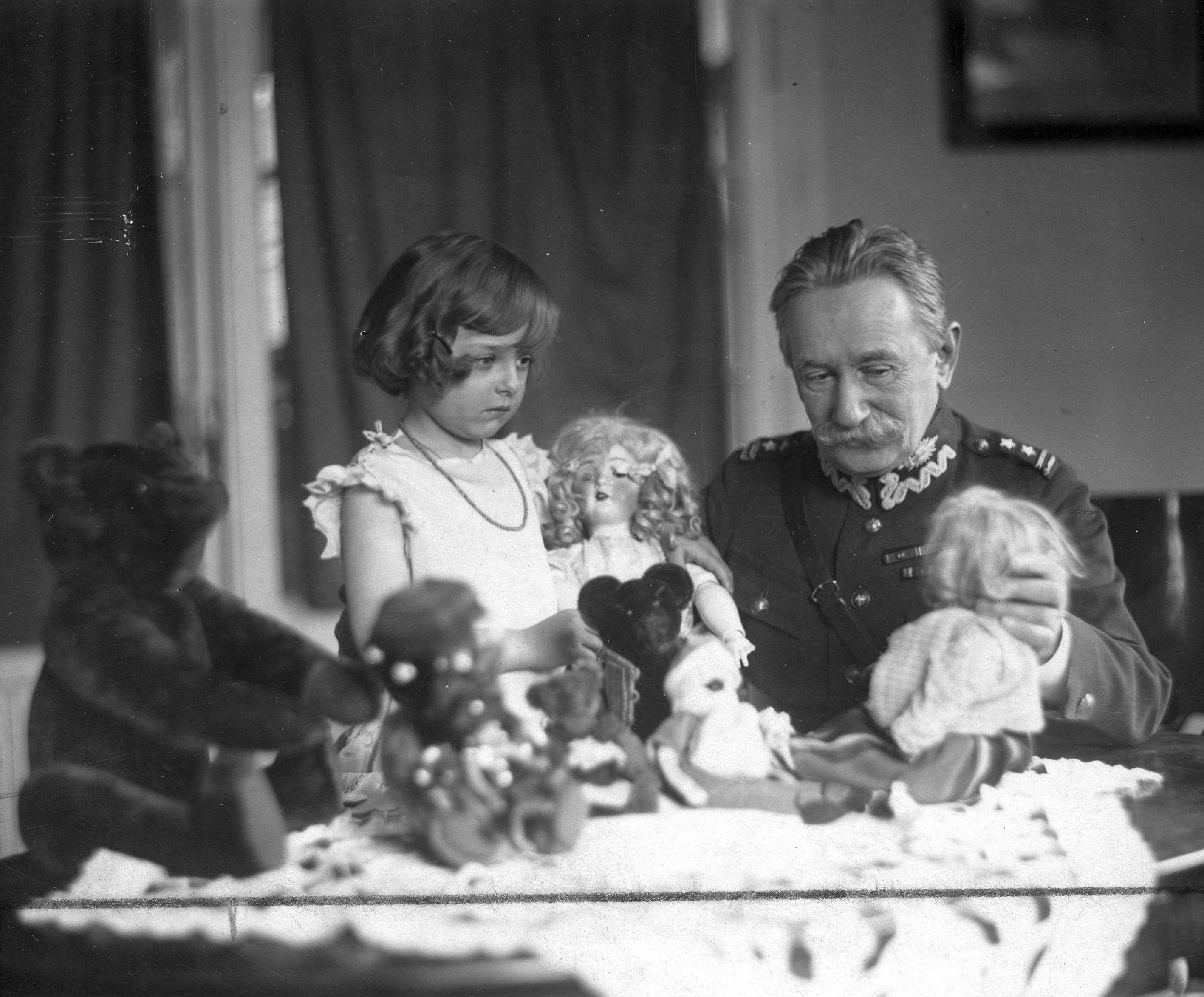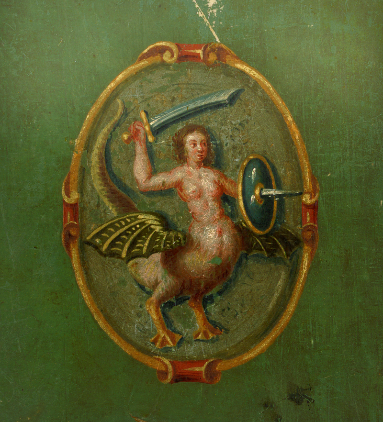Title of the work
Country of the First Edition
Country/countries of popularity
Original Language
First Edition Date
First Edition Details
Artur Oppman (Or-Ot), "Syrena” in Legendy warszawskie. Poznań–Warszawa–Wilno–Lublin: KSW [Księgarnia Św. Wojciecha], [1925], 9–20.
ISBN
Available Onllne
Syrena at Polona.pl (accessed: November 26, 2021).
Genre
Legends
Target Audience
Crossover
Cover

Public domain. Source: Polona (accessed: November 26, 2021).
Author of the Entry:
Marta Pszczolińska, University of Warsaw, m.pszczolinska@al.uw.edu.pl
Peer-reviewer of the Entry:
Katarzyna Marciniak, University of Warsaw, kamar@al.uw.edu.pl
Elżbieta Olechowska, University of Warsaw, elzbieta.olechowska@gmail.com

Taken in ca 1930. Narodowe Archiwum Cyfrowe, public domain (accessed: November 29, 2021).
Artur Oppman
[Or-Ot] , 1867 - 1931
(Author)
Artur Franciszek Michał Oppman (1867–1931), widely known under his pen-name Or-Ot, was a Polish poet, journalist, entrepreneur and collector, born in Warsaw to a family of mustard producers of German origin. At 16, his first publications appeared in journals and magazines. Shortly after, he became a staff literary reporter for Kurier Poranny. He also wrote for Kurier Warszawski, Kłosy and Tygodnik Ilustrowany. Later he co-edited Wędrowiec and Tygodnik Ilustrowany. He had frequent conflicts with censorship because of his keen interest in historical and patriotic content. Oppman also edited calendars and almanacs. He lived in Warsaw, in the district of Stare Miasto (Old Town), where he often hosted members of Warsaw literary and artistic establishment, including Bolesław Prus, Władysław Reymont, Kazimierz Przerwa-Tetmajer, Bolesław Leśmian, Stefan Żeromski or Wojciech Kossak. In 1920 he joined the Polish Army, where he actively attempted to create the structures of a military press. Having left the army in 1925, he traded antiquities and collected Varsaviana and militaria. In his house at 8 Kanonia street, he intended to open a museum of the history of Warsaw. As he was a passionate author of poems about the Old Town of Warsaw, and collector and publisher of old Warsaw legends, he is always identified with the area of his true interest – the city of Warsaw. He received many awards and decorations in Poland and abroad: the Polonia Restituta Officer’s Cross, the Golden Cross of Merit, the Order of the Star of Romania Officer’s Cross, the National Order of the Legion of Honour (Knight), and Ordre des Palmes académiques.
Sources:
Bartnicka, Józefa, “Oppman Artur” in Literatura polska. Przewodnik encyklopedyczny, PWN, Warszawa 1984–1985, vol. II, 87.
Kapuścik, Janusz and Piotr Stawecki, “Oppman Artur” in Polski słownik biograficzny, vol. 24, Wrocław: Zakład Narodowy im. Ossolińskich – Wydawnictwo Polskiej Akademii Nauk, 1979, 145–147.
Bio prepared by Marta Pszczolińska, University of Warsaw, m.pszczolinska@al.uw.edu.pl

Wacław Oppman (Illustrator)
Wacław Oppman was Artur Oppman’s brother. He designed the cover, vignette and illustrations for Legendy Warszawskie, Baśnie Polskie, Polski zaklęty świat and Pan Twardowski, written by his brother. After Artur’s death, he inherited the family business – the mustard factory founded by their father, Artur Emil Oppman.
Source:
Świątek, Tadeusz W., “Oppman”, available at polacyzwyboru.pl (accessed: December 17, 2021).
Bio prepared by Marta Pszczolińska, University of Warsaw, m.pszczolinska@al.uw.edu.pl
Adaptations
Performance for children staged at Teatr Lalka, adapted and directed by Jarosław Kilian, music by Grzegorz Turnau, cast: Bartosz Budny, Rafał Derkacz, Olga Ryl-Krystianowska, 2020. Available at Teatr Lalka YouTube channel (accessed: November 29, 2021).
Audiobook published by Teatr Syrena, voiced by Albert Osik, can be accessed at Teatr Syrena YouTube channel (accessed: November 29, 2021).
Audiobook published by Fundacja Słowo i Kropka and NaszeCzytanie.pl, voiced by Łukasz Chrzuszcz (accessed: November 29, 2021).
Audiobook published by Bajkowisko – bajki dla dzieci YouTube channel, voiced by Małgorzata Matuszewska (accessed: November 29, 2021).
Summary
Two fishermen talk about a siren whom one heard singing in the spring. They decide to ask an eremite – a clergyman – what should they do with her as she was not baptised. The eremite advises them to ambush her at the full moon and then deliver her to the local prince of Czersk. The siren comes out of the water at full moon, admires the night sky, and sings. She is seized and locked in the village under guard. The young shepherd looking after the prisoner is enchanted by her beautiful looks, crystalline voice and fascinating song. He frees her and helps her to the Vistula river, admiring her relation with the world of nature. The siren stops at the shore with sad regret as the village and the people she had been protecting had tried to enslave her. Despite this, she still promises to take care of the village and its inhabitants and sing them melodies of hope in difficult times because she deeply loves the land. At the same time, she promises never to be seen again. Eventually, the enchanted boy follows her into the waves (this subplot is removed in some post-war editions). The city of Warsaw, which replaced the old village, places the siren on its crest and makes her its symbol.
Analysis
The book, edited and published by Artur Oppman, is a collection of Warsaw legends rooted in oral tradition. The legend tells the story of the Warsaw Mermaid – now the city’s patron, its important symbol and the figure on its coat of arms – historically presented as several changing images. Oppman chose a well known Warsaw legend and presented it in his own way, adding a narrative layer with dialogues and vivid descriptions. The key character is the eponymous syrena. The author describes her as a beautiful water nymph, a mermaid, a maiden and a big fish hybrid. The nymph belongs to the world of nature; she lives in a creek, is shy as a hare and can even smell the presence of men. The Polish language does not differentiate between sirens and mermaids, using one name for both, syrena. Though she is not described here like the Homeric half-woman- half-bird, early images on municipal seals, documents and/or the crest render the creature much more like a siren than a mermaid. Regestrum proventuum et expensorum civitatis antiq[ue] varsaviae, published in 1652, presents a creature resembling a siren as imagined in the remote past (see below). Despite her partial animal identity, the syrena has a personality and is endowed with human traits. The fishermen of that time regarded her in categories of Christian morality, as a pagan and a possible witch. At the same time, they personify her and consider her more a human being than a wild creature. The reason is, of course, her beauty, crystalline voice, the ability to sing and speak. They fear (and admire) her as an unknown “other”, unsure whether any contact with the maiden could doom their Christian souls.
It is unclear whether classical elements are an inherent part of the folktale or whether the author himself enriched the story with these details. Regardless, the siren shares many common elements with the ancient archetype. Among her characteristics, the author mentions the ability to sing enchanting melodies. Her siren song works on humans and influences other living beings: trees, cows, even the sky and stars seem to listen to her music. The seductive power of the siren song, which causes death to its listeners, is present in ancient sources*, and it is confirmed here by the image of a bewitched shepherd blindly following the siren into the deep. Interestingly, the Homeric motif from the Odyssey of blocking the ears with wax** to avoid the bewitching power of the song also appears in the legend. The hermit cautions the fishermen to use wax to remain deaf to the siren’s plea.

Public domain, source: AGAD Archiwum Główne Akt Dawnych, available at Wikimedia commons (accessed: December 17, 2021).
* ὅς τις ἀιδρείῃ πελάσῃ καὶ φθόγγον ἀκούσῃ / Σειρήνων, τῷ δ᾽ οὔ τι γυνὴ καὶ νήπια τέκνα / οἴκαδε νοστήσαντι παρίσταται οὐδὲ γάνυνται, / ἀλλά τε Σειρῆνες λιγυρῇ θέλγουσιν ἀοιδῇ / ἥμεναι ἐν λειμῶνι
… the Sirens […] beguile all men whosoever comes to them. Whoso in ignorance draws near to them and hears the Sirens' voice, he nevermore returns, that his wife and little children may stand at his side rejoicing, but the Sirens beguile him with their clear-toned song… Homer, Od. 9.39 ff., trans. A. T. Murray.
** ἀλλὰ παρεξελάαν, ἐπὶ δ᾽ οὔατ᾽ ἀλεῖψαι ἑταίρων / κηρὸν δεψήσας μελιηδέα, μή τις ἀκούσῃ / τῶν ἄλλων:
But do thou row past them, and anoint the ears of thy comrades with sweet wax, which thou hast kneaded, lest any of the rest may hear. Ibidem 9.49.
Further Reading
90. rocznica świerci Artura Oppmana, available at Zakład Narodowy im. Ossolińskich website (accessed: November 29, 2021).
Apollonius Rhodius, Argonautica, George W. Mooney, ed., London: Longmans, Green, 1912.
Bukowiecki, Łukasz, "Legendy warszawskie czytane na dystans. Mapowanie podań lokalnych w perspektywie geopoetyki i geografii literackiej”, Dzieciństwo. Literatura i kultura 3.1 (2021): 11–25.
Homer, The Odyssey with an English Translation by A. T. Murray, Cambridge, MA.: Harvard University Press, London: Heinemann, 1919.
Niewieczerzał, Marta, “Stare i nowe miasto. Przyszłość bohaterów warszawskich legend”, Literatura Ludowa 1 (2019): 32–39.
Addenda
The legend inspired various authors.
Oppman’s Legendy warszawskie, including the legend of the Warsaw Mermaid, has been published over 20 times.
Syrena was included in the curriculum as a school-reader and was part of collections of folkloric fairy tales, legends and stories, such as:
Klechdy domowe, Hanna Kostyrko, ed., Warszawa: Nasza Księgarnia, 1960,
Zaklęty pierścień, Maria Kochanowska, ed., Warszawa: Nasza Księgarnia, 1982.


